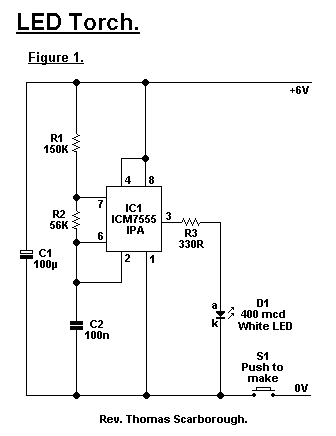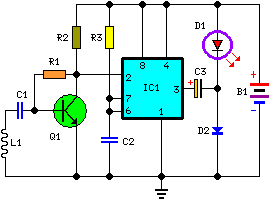
Light alarm schematic circuit diagram

This light alarm schematic circuit is designed using common electronic components, as illustrated in the circuit diagram below. The light alarm circuit will activate an alarm as soon as the drawer is opened and light falls on the Darlington phototransistor. The output alarm can be modified to trigger either a relay or a triac. The 14011 quad, two-input NAND gate is configured to oscillate when its input goes high; this occurs when the BC557 transistor is activated by light detected by the MAL12 phototransistor. Once the alarm is triggered and the circuit is returned to dark conditions, the alarm will continue to sound for approximately 3 to 5 seconds. This delay is facilitated by a 1uF capacitor and a 4.7M resistor, which maintain the input to the 14011 in a high state.
This light alarm circuit employs a Darlington phototransistor, which is sensitive to light changes, making it suitable for detecting when a drawer is opened. The core functionality relies on the interaction between the MAL12 phototransistor and the BC557 transistor, where the presence of light causes the BC557 to conduct. This action sends a high signal to the inputs of the 14011 NAND gate, initiating oscillation and triggering the alarm.
The design allows for flexibility in output configuration; the alarm can be connected to a relay for controlling higher power devices or a triac for AC applications. The choice of components reflects a balance between sensitivity and reliability, ensuring that the alarm system responds promptly to the opening of the drawer.
The delay mechanism provided by the capacitor and resistor creates a brief continuation of the alarm sound even after the light is no longer detected. This feature can be particularly useful in scenarios where immediate silence is not desired, allowing users a moment to react or address the situation. The values of the capacitor and resistor can be adjusted to modify the duration of the alarm sound, providing further customization for specific applications.
Overall, this light alarm circuit is an effective solution for alerting users to the status of a drawer or similar enclosure, enhancing security and awareness in various environments.This light alarm schematic circuit is designed using some common electronic parts, as you can see in the circuit diagram bellow. This light alarm schematic circuit project will sound as soon as the drawer is opened and light falls on the Darlington phototransistor.
The output alarm may be redesigned to activate a relay or triac. The 14011 quad, 2 input, NAND gate is wired up to oscillate when the input to it goes high, that is the BC557 transistor turns on after light is detected by the MAL12. After the alarm has started and it is put back into dark conditions, alarm will continue to sound for about 3 - 5 seconds.
This is due to the 1uF capacitor and 4M7 resistor which keep the input to the 14011 high. 🔗 External reference
This light alarm circuit employs a Darlington phototransistor, which is sensitive to light changes, making it suitable for detecting when a drawer is opened. The core functionality relies on the interaction between the MAL12 phototransistor and the BC557 transistor, where the presence of light causes the BC557 to conduct. This action sends a high signal to the inputs of the 14011 NAND gate, initiating oscillation and triggering the alarm.
The design allows for flexibility in output configuration; the alarm can be connected to a relay for controlling higher power devices or a triac for AC applications. The choice of components reflects a balance between sensitivity and reliability, ensuring that the alarm system responds promptly to the opening of the drawer.
The delay mechanism provided by the capacitor and resistor creates a brief continuation of the alarm sound even after the light is no longer detected. This feature can be particularly useful in scenarios where immediate silence is not desired, allowing users a moment to react or address the situation. The values of the capacitor and resistor can be adjusted to modify the duration of the alarm sound, providing further customization for specific applications.
Overall, this light alarm circuit is an effective solution for alerting users to the status of a drawer or similar enclosure, enhancing security and awareness in various environments.This light alarm schematic circuit is designed using some common electronic parts, as you can see in the circuit diagram bellow. This light alarm schematic circuit project will sound as soon as the drawer is opened and light falls on the Darlington phototransistor.
The output alarm may be redesigned to activate a relay or triac. The 14011 quad, 2 input, NAND gate is wired up to oscillate when the input to it goes high, that is the BC557 transistor turns on after light is detected by the MAL12. After the alarm has started and it is put back into dark conditions, alarm will continue to sound for about 3 - 5 seconds.
This is due to the 1uF capacitor and 4M7 resistor which keep the input to the 14011 high. 🔗 External reference





